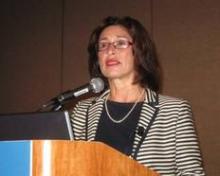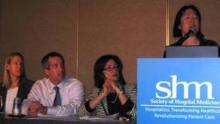SAN DIEGO – Hospitalists arrived in hope and in unabashed need of hearing about balancing work and home lives.
One said he was looking for tips on balancing the competing demands of work and home. "It’s never balanced," lamented another, a female hospitalist with a full-time physician husband and three children.
Someone else said he wanted to find ways to prevent burnout. "I’m already burned out," said another at the annual meeting of the Society of Hospital Medicine.
An office-based physician in private practice said he was wondering if hospital medicine might offer a "better," more balanced way to practice. "I just quit my job" due to burnout, one hospitalist admitted.
Work-life balance boils down to one’s relationships not only with others but with one’s self, said session moderator Dr. Carole Warde. She encouraged everyone to translate some of the same core competencies expected of hospitalists professionally to manage these relationships, including "be engaged," "listen actively," "work in teams," and "resolve conflicts."
"Relationships never come easy. They always come from a place of work," said Dr. Warde, who recently joined the Greater Los Angeles Veterans Affairs Health System to practice as a primary care physician and to set up the VA’s version of patient-centered medical homes.
She adapted a passage from the book by Parker J. Palmer, "The Courage to Teach: Exploring the Inner Landscape of a Teacher’s Life" (10th anniversary edition, Wiley, 2007) as it might apply to physicians: "As I practice, I project the condition of my soul onto my patients, colleagues, family, and friends and our way of being together. Doctoring holds a mirror to the soul. If I am willing to look at that mirror, I have a chance to gain self-knowledge. Knowing myself is as crucial to good doctoring as knowing my patients and my subject," Dr. Warde said.
"This isn’t something that anybody told me in medical school," she said. Physicians who don’t pay attention to their well-being risk emotionally withdrawing into a self-protective shell, which reduces their ability to understand patients’ needs, impairs clinical decision making, and leads to inattentiveness, loss of meaning, and burnout, she said.
A panel of three hospitalists at the session described their own attempts to balance work and home life.
Dr. Diana Childers, an academic hospitalist at the University of California, San Diego, said that with a husband in the U.S. Navy, two children, and her own diagnosis of type 1 diabetes to manage, "time off seems to disappear." She plans her exercise a week in advance. "If I can exercise three to four times a week, that’s good," she said.
She is supported by her husband, a nanny, a departmental chief who "lets me complain," and colleagues who reciprocate in covering for each other when needed. Dr. Childers encouraged hospitalists to join a volunteer project in the workplace to help them find a colleague that they can connect with and talk to about their work-life challenges.
Dr. Mark Shapiro, in private hospitalist practice in San Diego, said the reciprocal relationships between colleagues in his 12-person group also helped manage the stress of work schedules. The group is considering hiring some mid-level practitioners to share the load.
"One of the variables I realized I have the most control over is how I physically feel at the end of the day. That was something that wasn’t being paid attention to," he said. Dr. Shapiro now consciously reminds himself of basic such as drinking water to stay hydrated, and avoiding hospital food when possible.
Dr. Lisa Shieh, an academic hospitalist at Stanford (Calif.) University, said that support from her department chair to address frequently-changing work hours made a big difference in stress levels. Hiring a nanny and a gardener lets her spend more time with her husband (also a physician) and children.
Finding a mentor after 5 years as a hospitalist "really helped me," Dr. Shieh said. She regularly schedules lunch with a friend at work so they can unwind together, and taps people outside her group, too. "One of my best friends is a surgeon. Sometimes I just call him and say, ‘What do you think of this?’ " Dr. Shieh said.
Stress, Quantified
The U.S. Physician Work Life Study surveyed 5,704 primary care and subspecialty physicians and found that the key factors increasing or mitigating stress were demands (such as work hours, time pressures, or a heavy case mix), control (over workplace chaos, resources, and personal life), and support from colleagues and significant others (Stress Health 2002;18:37-42).



